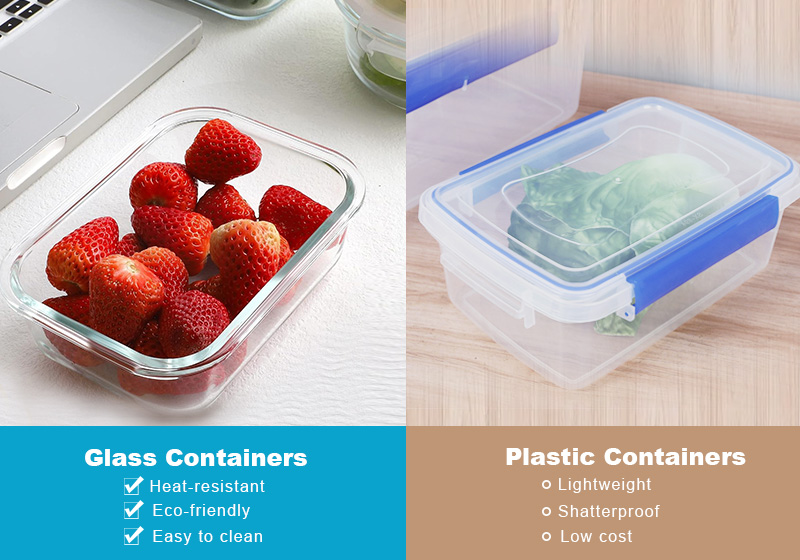The main differences between glass containers and plastic containers
The main differences between glass food storage containers and plastic containers:

1. Material and Composition:
Glass Containers: Made from high borosilicate glass or regular glass, which is heat and cold resistant and free of harmful chemicals. Glass is safe for health.
Plastic Containers: Made from various types of plastic (such as polypropylene or polyethylene), some of which may contain harmful chemicals like BPA, though many modern plastic containers are BPA-free.
2. Heat Resistance:
Glass Containers: Glass containers have high heat resistance and can be used directly in microwaves, ovens, or other heating devices without warping or releasing harmful substances.
Plastic Containers: Most plastic containers are not heat-resistant and can warp or release harmful chemicals when exposed to high temperatures.
3. Ease to clean:
Glass Containers: Glass does not absorb food odors, is easy to clean, and won't stain or yellow over time.
Plastic Containers: Plastic tends to absorb food smells and oils. Over time, they can stain or yellow, and cleaning requires more effort.
4. Weight:
Glass Containers: Glass is relatively heavier than plastic, making it less convenient for carrying around but more stable and durable.
Plastic Containers: Plastic is lightweight and portable, making it ideal for daily use and storage.
5. Durability:
Glass Containers: Glass is durable but fragile. It can break or shatter if dropped, requiring careful handling.
Plastic Containers: Plastic containers are more resistant to breaking but can become scratched, worn, or brittle over time.
6. Environmental Impact:
Glass Containers: Glass is eco-friendly as it is reusable and does not release harmful substances. It also has a longer lifespan.
Plastic Containers: Many plastics are not biodegradable, and their long-term use can contribute to environmental pollution.
7. Price:
Glass Containers: Glass containers are generally more expensive, especially higher-quality ones, and their weight increases shipping costs.
Plastic Containers: Plastic containers are cheaper, making them more cost-effective for everyday use.
8. Appearance:
Glass Containers: Glass is typically clearer and more elegant, offering a modern look. It is ideal for showcasing food.
Plastic Containers: Plastic containers come in various styles, but they tend to be less transparent, and their appearance is often not as refined as glass.
9. Sealing capability:
Glass Containers: Glass containers typically offer excellent sealing capabilities, especially those with silicone seals. They effectively prevent air, moisture, and odors from entering, preserving food freshness for longer periods.
Plastic Containers: Plastic containers also offer good sealing, especially those with silicone seals, but their sealing capability may diminish over time due to the plastic aging and wear.
Summary:
Glass Containers: Ideal for those who prioritize health, cleanliness, eco-friendliness, and excellent sealing. They are perfect for storing food that needs to be heated, as they can withstand high temperatures and maintain freshness.
Plastic Containers: Suitable for those on a budget who prioritize convenience, portability, and low cost. While plastic containers also have good sealing, the sealing ability may decrease over time, especially with frequent use.
Choose the container that best fits your needs and usage scenario.
